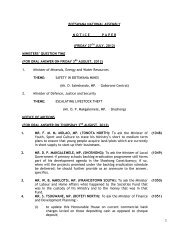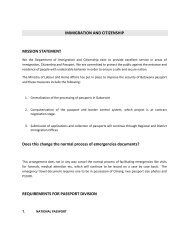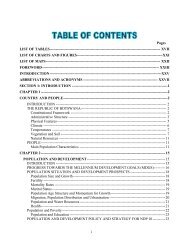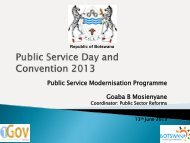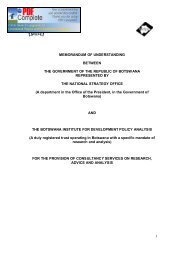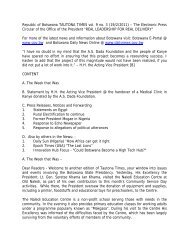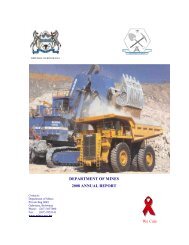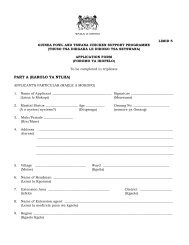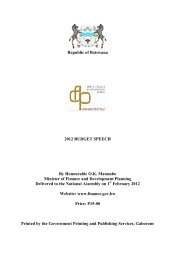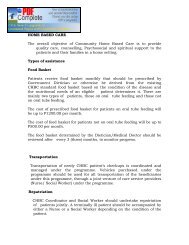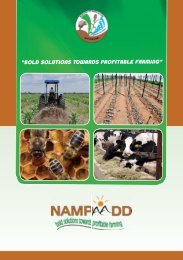Roads Department - Government of Botswana
Roads Department - Government of Botswana
Roads Department - Government of Botswana
Create successful ePaper yourself
Turn your PDF publications into a flip-book with our unique Google optimized e-Paper software.
<strong>Roads</strong> <strong>Department</strong><br />
2.2 Salt Damage Occurrence in <strong>Botswana</strong><br />
Figure 2.2 shows areas <strong>of</strong> <strong>Botswana</strong> (lighter shaded) most susceptible to the<br />
occurrence <strong>of</strong> salt damage to bituminous surfacings. In these areas the dry<br />
climate combined with the presence <strong>of</strong> saline materials (<strong>of</strong>ten calcrete) and<br />
saline groundwater or surface water (such as Sua Pan) create conditions necessary<br />
for salt damage to occur. Reported locations <strong>of</strong> salt damage in <strong>Botswana</strong><br />
include:<br />
Shakawe<br />
Maun<br />
Nata<br />
Ghanzi<br />
Orapa<br />
Francistown<br />
Maron grass, a tough, coarse grass not liked by<br />
cattle, found on some road verges can indicate<br />
presentce <strong>of</strong> saline ground. Western part <strong>of</strong> the<br />
Kalahari desert.<br />
Mamuno<br />
Kang<br />
Bobonong<br />
Sekoma<br />
Gaborone<br />
Tsabong<br />
Bokspits<br />
Figure 2.2 Dark areas are less susceptible to occurrence <strong>of</strong> salt damage<br />
Salt damage during the construction <strong>of</strong><br />
- Mopipi-Rakops<br />
- Sekoma-Makopong<br />
- Kang -Hukuntsi<br />
were prevented by judicious materials selection<br />
using conductivity tests.<br />
Sua Pan Airstrip<br />
Nata - Maun Road (km 0-45)<br />
Phikwe Runway<br />
Sekoma - Kang road (Trans-Kalahari road)<br />
Sekoma - Makopong<br />
Kang - Hukuntsi<br />
Tsabong - Makopong road<br />
Orapa - Mopipi road<br />
Rakops-Motopi<br />
Maun Runway<br />
The first four above cases are described below together with the preventative<br />
measures adopted.<br />
Domed cape seal surfacing due to salt attack<br />
Sua Pan Airstrip.<br />
Sua Pan Airstrip<br />
The Sua Pan airstrip was constructed in 1988. The pavement comprised calcrete<br />
subbase and base with a Cape Seal bituminous surfacing. Within six<br />
months after construction, the surfacing developed star shaped blisters and<br />
domes ranging in size from a few millimetres to 15 mm in diametre and 1 to<br />
5 mm in height. The damage occurred initially in the untrafficked edges <strong>of</strong> the<br />
runway and progresed towards the centre <strong>of</strong> the runway. Some <strong>of</strong> the domes<br />
had opened up to reveal clusters <strong>of</strong> white salt crystals.<br />
12 Chapter 2<br />
Guide to the Prevention and Repair <strong>of</strong> Salt Damage to <strong>Roads</strong> and Runways<br />
Occurrence and Characteristics



